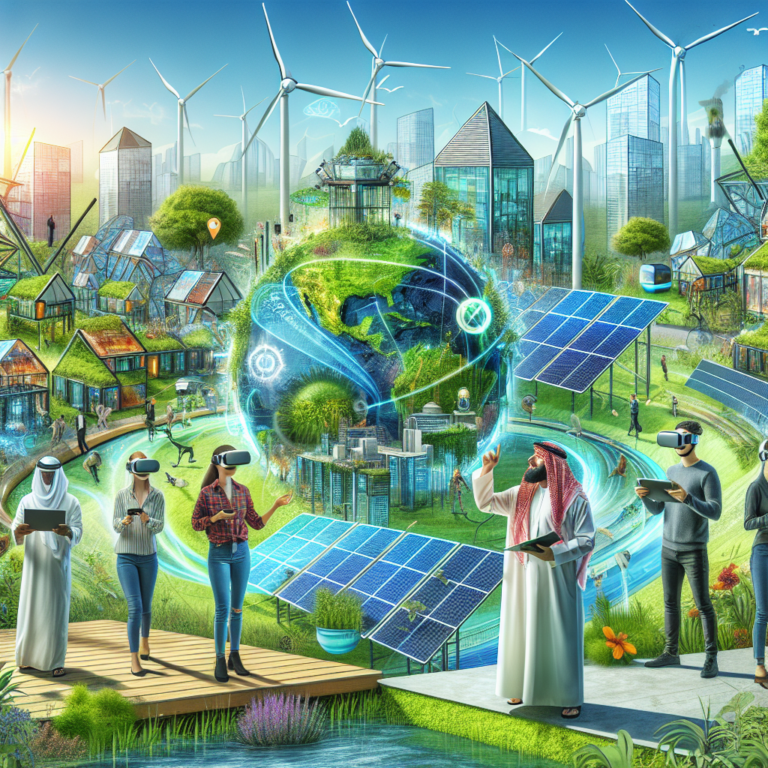Embracing Immersive Technologies: A Pathway to Sustainability 🌍
Navigating the Challenge of Short Life Cycles
The landscape of immersive technologies, such as virtual reality (VR) and augmented reality (AR), is evolving at a breathtaking pace. However, this rapid evolution presents unique challenges for educational providers and organizations. Balancing technological innovation with environmental sustainability becomes paramount as these technologies undergo frequent updates and replacements.
Extending the Lifespan of Immersive Technology
To mitigate the environmental impact of device turnover, educational institutions and organizations can implement several strategies:
- Device Security: Keeping devices secure prolongs their use and reduces the likelihood of premature waste.
- Safety Training: Providing thorough training on using immersive technologies minimizes accidents and the need for replacements.
- Proper Storage: Investing in protective cases and proper storage systems guards devices against damage and environmental factors.
- Recycling Schemes: Implementing robust recycling programs for end-of-life devices can help reclaim materials and reduce electronic waste.
Preserving XR Content for Future Generations
As immersive technologies progress, there is growing concern about the preservation of XR (Extended Reality) content. The Digital Preservation Coalition has raised alarms about the risk of losing valuable virtual reality experiences due to outdated software and applications. To safeguard this content, organizations should:
- Follow Industry Standards: Adhering to best practices set by organizations like IEEE, W3C, and Khronos Group ensures interoperability and accessibility.
- Promote Collaboration: Engaging in collaborative approaches to content development, such as setting up headset-sharing processes, enhances the use and longevity of XR content.
Inviting Diverse Perspectives
In discussions surrounding immersive technologies, it’s essential to involve various stakeholders, including French-speaking organizations. Building a community that encompasses diverse voices can lead to more responsible and inclusive outcomes.
Emphasizing Sustainability in Immersive Technology
With environmental concerns becoming a focal point, adopting a sustainable approach to immersive technologies is critical. Organizations should incorporate the carbon footprint associated with their technology use into their overall assessments.
The Growth Potential of Immersive Technologies
The potential applications of immersive technologies are vast, with Meta projecting that these innovations will contribute significantly to the global GDP by 2035. Sectors such as health, education, and entertainment stand to benefit tremendously from this technological advancement.
Case Studies: Innovative Uses of Immersive Technology
Several companies are leading the way in harnessing immersive technology for the greater good:
- Orange: Their “Eternal Notre-Dame” VR experience and “Safe Zones” initiative illustrate how immersive tech can address social issues like cyberbullying.
Governance and Regulation in Immersive Environments
As immersive technologies develop, so does the need for robust governance frameworks. Compliance with existing regulations, such as the GDPR, and the establishment of new regulatory structures specific to immersive technologies is crucial.
Recommendations for a Sustainable Future
A recent white paper has put forward several recommendations to enhance the integration of sustainability in immersive practices:
- Standardization: Call for the standardization of methods to assess ecological impacts associated with immersive technologies.
- Multistakeholder Approaches: Emphasizing collaboration on cross-border issues related to immersive technology application.
The Role of VR in Supporting Sustainable Development Goals (SDGs)
Immersive technologies are not just about entertainment; they are integral to achieving the United Nations Sustainable Development Goals (SDGs). Specifically, SDG#11 focuses on promoting sustainable cities and communities. As urban populations grow, immersive technologies can help address challenges such as:
- Inequality: Ensuring equal access to immersive resources and experiences.
- Energy Consumption: Developing smarter energy solutions in urban environments.
- Pollution: Utilizing VR to visualize and strategize urban planning that prioritizes clean air and minimal carbon emissions.
How VR Can Revolutionize Environmental Sustainability
The VR market is expected to soar to a worth of $22 billion by 2025, despite earlier concerns regarding its environmental sustainability. Researchers and advocates are exploring how VR can promote sustainable infrastructure, remote working, and eco-friendly practices. Here are some avenues through which VR contributes to environmental sustainability:
- Remote Learning and Working: VR reduces transport emissions significantly via virtual shopping experiences.
- Efficient Data Centers: Many VR experiences now run on clean energy sources, drastically cutting the carbon footprint.
- Urban Development: Projects utilizing VR help professionals visualize building plans that reduce waste.
Examples of VR Projects Driving Change
Highlighted projects include:
- “This is Climate Change”: A project using VR to immerse users in the realities of climate change.
- Lancôme: Implementing VR for customers to shop from home, thus minimizing commuting.
- Smart Cities: Cities like Singapore are leveraging VR to improve energy efficiency and urban sustainability.
Innovative Initiatives in Construction
The CONVERT program in the UK’s construction industry stands out with its immersive learning approach, targeting accident reduction and error minimization. This ambitious project aims to:
- Engage over 8000 beneficiaries in a safe learning environment.
- Educate young people about career opportunities in sustainability-focused sectors.
- Present a virtual construction site for learners to experiment with sustainable building practices.
Pioneering Sustainability in Immersive Experiences
Companies like Grande Experiences are trailblazing sustainability in the immersive experiences industry. Their commitment includes:
- Using lampless projectors and LED lighting to cut down on waste.
- Selecting durable equipment to reduce turnover and transportation impact.
- Implementing recycling programs to minimize electronic waste.
By embracing these practices and striving for a greener future, immersive technologies hold the potential to transform how we interact with our world, ensuring a sustainable planet for generations to come.




0 Comments